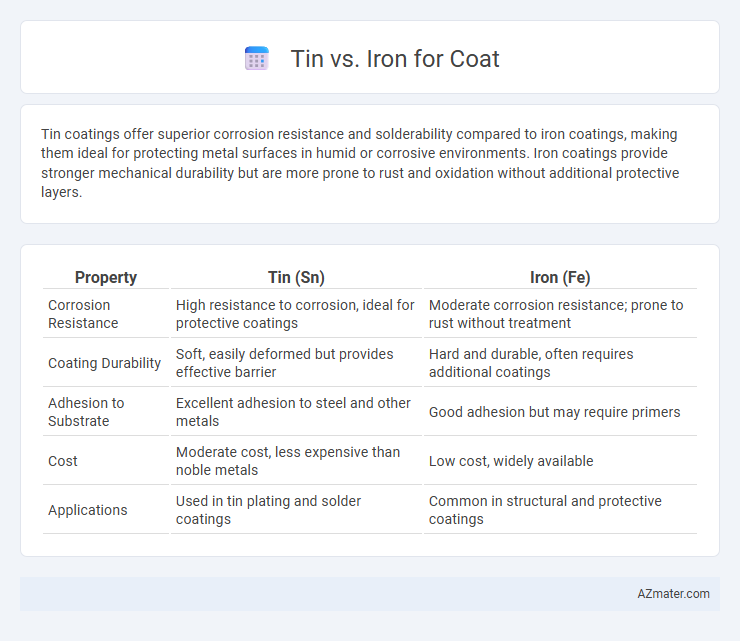Tin coatings offer superior corrosion resistance and solderability compared to iron coatings, making them ideal for protecting metal surfaces in humid or corrosive environments. Iron coatings provide stronger mechanical durability but are more prone to rust and oxidation without additional protective layers.
Table of Comparison
| Property | Tin (Sn) | Iron (Fe) |
|---|---|---|
| Corrosion Resistance | High resistance to corrosion, ideal for protective coatings | Moderate corrosion resistance; prone to rust without treatment |
| Coating Durability | Soft, easily deformed but provides effective barrier | Hard and durable, often requires additional coatings |
| Adhesion to Substrate | Excellent adhesion to steel and other metals | Good adhesion but may require primers |
| Cost | Moderate cost, less expensive than noble metals | Low cost, widely available |
| Applications | Used in tin plating and solder coatings | Common in structural and protective coatings |
Introduction: Choosing the Right Coat Material
Tin and iron offer distinct advantages as coat materials, with tin providing excellent corrosion resistance and a lightweight structure, while iron boasts superior strength and durability. Selecting between tin and iron depends on environmental exposure and desired longevity, as tin suits moisture-prone settings and iron excels in robust protection. Understanding these material properties helps in making an informed decision for optimal coat performance.
Overview of Tin and Iron as Coat Materials
Tin offers excellent corrosion resistance and a smooth, non-reactive surface ideal for protective coatings, while iron provides superior strength and durability but is prone to rust without proper treatment. Tin coatings are often used in food packaging to prevent contamination, whereas iron coatings are common in structural applications where mechanical strength is critical. The choice between tin and iron for coating depends on the required balance of corrosion resistance and mechanical performance.
Physical Properties: Tin vs Iron
Tin exhibits a low melting point of 232degC and excellent corrosion resistance, making it ideal for protective coatings on metals. Iron, with a much higher melting point of 1538degC, offers superior strength and hardness but is prone to rust without proper treatment. The softness and malleability of tin allow for easy application as a thin, uniform coat, whereas iron's rigidity limits its use primarily to structural components rather than coatings.
Durability and Longevity Comparison
Iron coatings offer superior durability compared to tin due to their resistance to corrosion and wear, making them ideal for long-term applications. Tin coatings provide moderate protection but are more susceptible to oxidation and mechanical damage, reducing their lifespan. When evaluating longevity, iron coatings typically outperform tin, ensuring extended structural integrity and reduced maintenance requirements.
Corrosion and Rust Resistance
Tin offers superior corrosion and rust resistance compared to iron due to its ability to form a stable, protective oxide layer that prevents moisture and oxygen penetration. Iron, while strong, is prone to rust when exposed to water and air, leading to corrosion that weakens its structural integrity over time. Coating iron with tin significantly enhances durability by providing a corrosion-resistant barrier that extends the lifespan of the underlying metal.
Weight and Comfort in Daily Use
Tin coats are lighter than iron coats, making them more comfortable for daily wear due to reduced strain on the body. The low density of tin results in less bulky outerwear, enhancing mobility and easing prolonged use. Iron coats, being heavier and denser, tend to cause fatigue and restrict movement over extended periods.
Thermal Conductivity and Insulation
Tin exhibits a thermal conductivity of approximately 66 W/m*K, which is higher than iron's thermal conductivity of about 80 W/m*K, indicating iron transfers heat more efficiently. For coating applications requiring insulation, iron's comparatively lower thermal conductivity makes it a better option to reduce heat transfer. Tin coatings provide moderate thermal resistance but excel in corrosion protection rather than insulation performance.
Cost Effectiveness and Availability
Tin is more expensive than iron due to its limited availability and higher extraction costs, making iron a more cost-effective option for coating applications. Iron is abundant and widely accessible, which drives down its price and ensures steady supply for industrial use. The affordability and availability of iron make it the preferred choice for large-scale coating projects requiring economical and reliable materials.
Environmental Impact and Recyclability
Tin offers a lower environmental impact compared to iron due to its less energy-intensive extraction process and reduced greenhouse gas emissions during production. Iron, while heavier and more resource-demanding to mine and refine, boasts superior recyclability rates, with up to 90% of steel alloys reused in new products, minimizing landfill waste. Both metals contribute to sustainable material cycles, but tin's lesser carbon footprint combined with iron's efficient recycling infrastructure highlights a balance between environmental impact and recyclability in coat manufacturing.
Best Uses: Recommendations for Tin and Iron Coats
Tin coatings excel in corrosion resistance and are ideal for food containers and electrical components due to their non-toxic properties and excellent solderability. Iron coatings, particularly in the form of galvanized steel, provide superior durability and abrasion resistance, making them best suited for construction, automotive parts, and heavy machinery exposed to harsh environments. Choosing tin-coated products is recommended for applications requiring a smooth, non-reactive surface, while iron-coated items are preferred for structural strength and long-term outdoor exposure.

Infographic: Tin vs Iron for Coat
 azmater.com
azmater.com